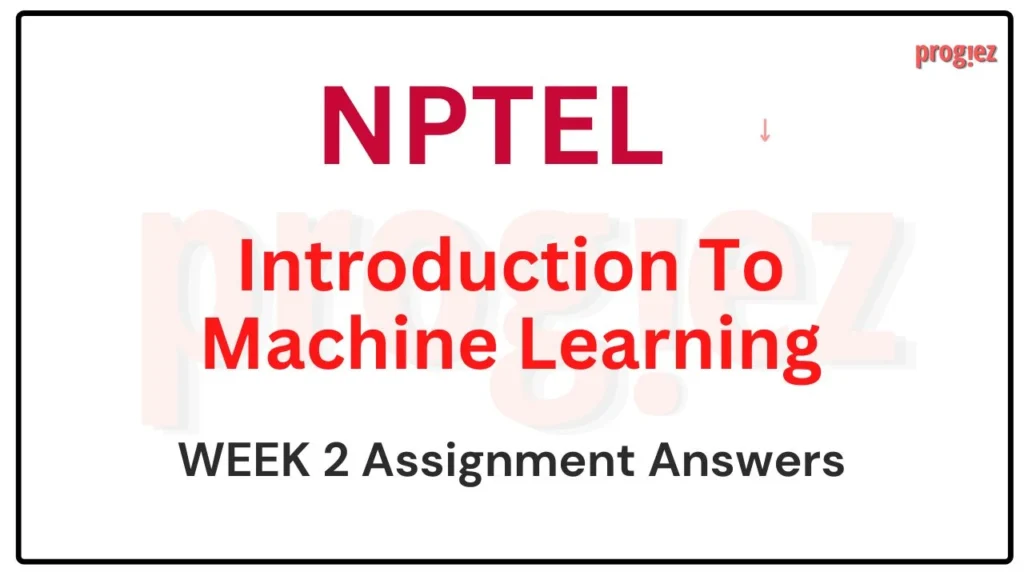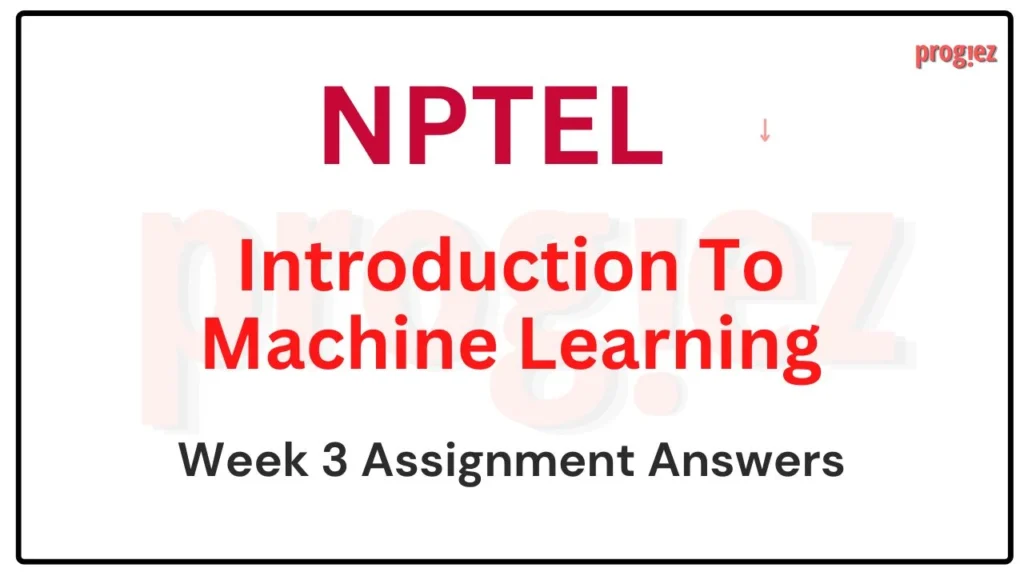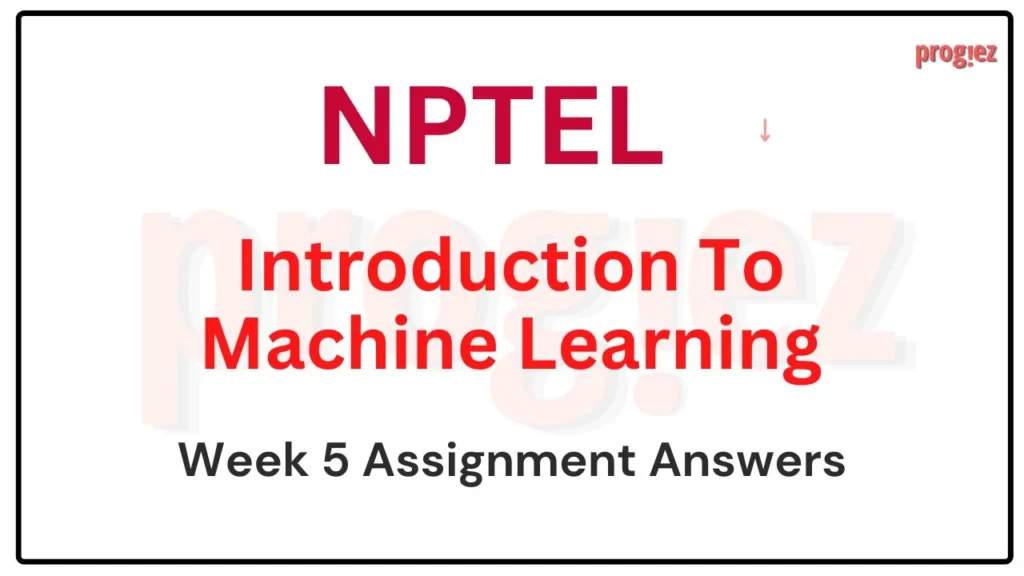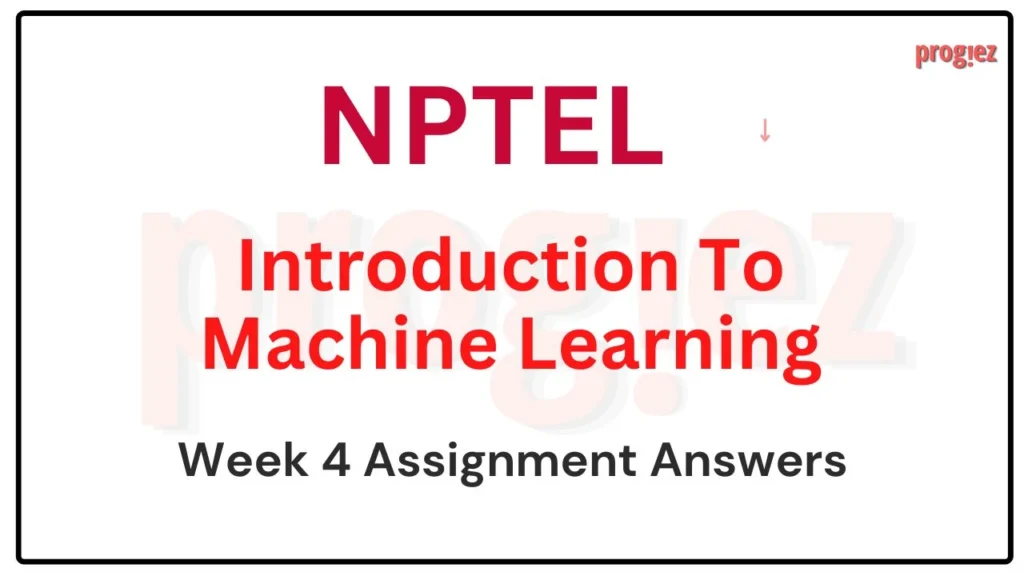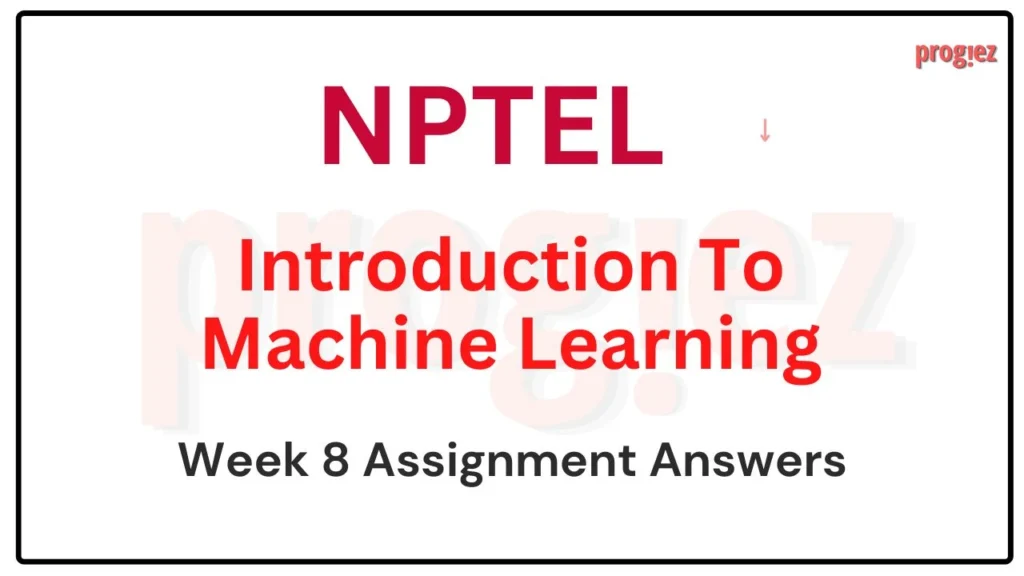Introduction To Machine Learning Week 1 Nptel Answers
Are you looking for the NPTEL Introduction to Machine Learning Week 1 Assignment Answers 2025 (July-Dec)? You’re in the right place! Our detailed solutions cover essential machine learning concepts such as supervised learning, unsupervised learning, and key algorithms like linear regression and k-nearest neighbors.
Table of Contents
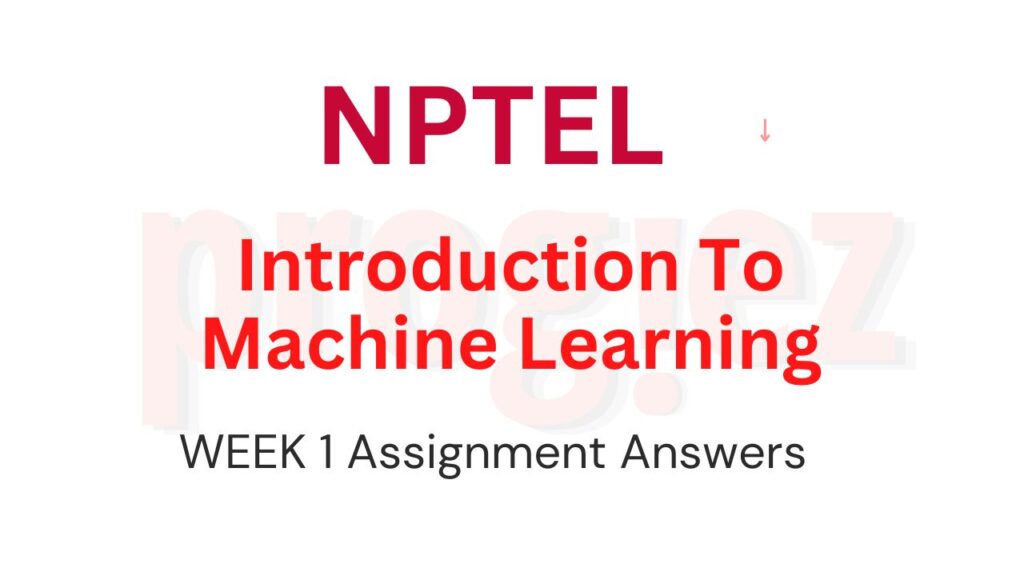
Introduction To Machine Learning Week 1 Nptel Answers (Jan-Apr 2025)
Course Link: Click Here
Que. 1) Which of the following is/are unsupervised learning problem(s)?
A) Sorting a set of news articles into four categories based on their titles
B) Forecasting the stock price of a given company based on historical data
C) Predicting the type of interaction (positive/negative) between a new drug and a set of human proteins
D) Identifying close-knit communities of people in a social network
E) Learning to generate artificial human faces using the faces from a facial recognition dataset
Que. 2) Which of the following statement(s) about Reinforcement Learning (RL) is/are true?
A) While learning a policy, the goal is to maximize the reward for the current time step
B) During training, the agent is explicitly provided the most optimal action to be taken in each state
C) The actions taken by an agent do not affect the environment in any way
D) RL agents used for playing turn-based games like chess can be trained by playing the agent against itself (self-play)
E) RL can be used in an autonomous driving system
Que. 3) Which of the following is/are regression tasks(s)?
A) Predicting whether an email is spam or not spam
B) Predicting the number of new COVID cases in a given time period
C) Predicting the total number of goals a given football team scores in a year
D) Identifying the language used in a given text document
Que. 4) Which of the following is/are classification task(s)?
A) Predicting whether or not a customer will repay a loan based on their credit history
B) Forecasting the weather (temperature, humidity, rainfall, etc.) at a given place for the following 24 hours
C) Predicting the price of a house 10 years after it is constructed
D) Predicting if a house will be standing 50 years after it is constructed
Que. 5) Consider the following dataset. Fit a linear regression model of the form
y = β₀ + β₁x₁ + β₂x₂ using the mean-squared error loss. Using this model, the predicted value of y at the point (x₁, x₂) = (0.5, −1.0) is:
A) 4.05
B) 2.05
C) −1.95
D) −3.95
Que. 6) Consider the following dataset. Using a k-nearest neighbor (k-NN) regression model with k = 3, predict the value of y at (x₁, x₂) = (1.0, 0.5). Use the Euclidean distance to find the nearest neighbors.
A) −1.766
B) −1.166
C) 1.133
D) 1.733
Que. 7) Consider the following dataset with three classes: 0, 1, and 2. x₁ and x₂ are the independent variables, whereas y is the class label. Using a k-NN classifier with k = 5, predict the class label at the point (x₁, x₂) = (1.0, 1.0). Use the Euclidean distance to find the nearest neighbors.
A) 0
B) 1
C) 2
D) Cannot be predicted
Que. 8) Consider the following statements regarding linear regression and k-NN regression models. Select the true statements.
A) A linear regressor requires the training data points during inference
B) A k-NN regressor requires the training data points during inference
C) A k-NN regressor with a higher value of k is less prone to overfitting
D) A linear regressor partitions the input space into multiple regions such that the prediction over a given region is constant
Que. 9) Which of the following statement(s) regarding bias and variance is/are correct?
A) Bias = E[(E[f̂(x)] − f̂(x))²]; Variance = E[(f̂(x) − f(x))²]
B) Bias = E[f̂(x)] − f(x); Variance = E[(E[f̂(x)] − f̂(x))²]
C) Low bias and high variance is a sign of overfitting
D) Low variance and high bias is a sign of overfitting
E) Low variance and high bias is a sign of underfitting
**Que. 10) Suppose that we train two kinds of regression models corresponding to the following equations.
(i) y = β₀ + β₁x₁ + β₂x₂
(ii) y = β₀ + β₁x₁ + β₂x₂ + β₃x₁x₂ + β₄x₁² + β₅x₂²
Which of the following statement(s) is/are correct?**
A) On a given training dataset, the mean-squared error of (i) is always less than or equal to that of (ii)
B) (i) is likely to have a higher variance than (ii)
C) (ii) is likely to have a higher variance than (i)
D) If (i) overfits the data, then (ii) will definitely overfit
E) If (ii) underfits the data, then (i) will definitely underfit
Introduction To Machine Learning Week 1 Nptel Answers (July-Dec 2024)
Q1.Which of the following are supervised learning problems (Multiple Correct)?
Clustering Spotify users based on their listening history
Weather forecast using data collected by a satellite
Predicting tuberculosis using patient’s chest X-Ray
Training a humanoid to walk using a reward system
Q2. Which of the following are regression tasks (Multiple Correct)?
Predicting the outcome of an election
Predicting the weight of a giraffe based on its weight
Predicting the emotion conveyed by a sentence
Identifying abnormal data points
For answers or latest updates join our telegram channel: Click here to join
These are Introduction To Machine Learning Week 1 Nptel Assignment Answers
Q3.Which of the following are classification tasks (Multiple Correct)?
Predicting the outcome of an election
Predicting the weight of a giraffe based on its weight
Predicting the emotion conveyed by a sentence
Identifying abnormal data points
Answer:a) Predicting the outcome of an election , c)Predicting the emotion conveyed by a sentence
d)Identifying abnormal data points
Q4. Which of the two functions overfit the training data?
Both functions F1 & F2
Function F1
Function F2
None of them
Answer: Function F1
For answers or latest updates join our telegram channel: Click here to join
These are Introduction To Machine Learning Week 1 Nptel Assignment Answers
Q5. Which of the following 2 functions will yield higher training error?
Function F1
Function F2
Both functions F1 & F2 will have the same training error
Can not be determined
Answer: Function F2
Q6. What does the term ‘policy’ refer to in reinforcement learning?
A set of rules governing the environment
The reward function
The initial state of the environment
The strategy the agent follows to choose actions
Answer: The strategy the agent follows to choose actions
For answers or latest updates join our telegram channel: Click here to join
These are Introduction To Machine Learning Week 1 Nptel Assignment Answers
Q7. Given the following dataset, for k = 3, use KNN regression to find the prediction for a new data-point (2,3) (Use Euclidean distance measure for finding closest points)
2.0
2.6
2.8
3.2
Answer:2.8
Q8.For any given dataset, comment on the bias of K-nearest classifiers upon increasing the value of K
The bias of the classifier decreases
The bias of the classifier does not change
The bias of the classifier increases
Can not be determined
Answer: The bias of the classifier does not change
For answers or latest updates join our telegram channel: Click here to join
These are Introduction To Machine Learning Week 1 Nptel Assignment Answers
Q9. Bias and variance are given by:
E[f^(x)]−f(x),E[(E[f^(x)]−f^(x))2]
E[f^(x)]−f(x),E[(E[f^(x)]−f^(x))]2
(E[f^(x)]−f(x))2,E[(E[f^(x)]−f^(x))2]
(E[f^(x)]−f(x))2,E[(E[f^(x)]−f^(x))]2
Answer: c)
Q10.Which of the following statements are FALSE regarding bias and variance?
Models which overfit have a high bias
Models which overfit have a low bias
Models which underfit have a high variance
Models which underfit have a low variance
Answer: a) Models which overfit have a high bias, c)Models which underfit have a high variance
For answers or latest updates join our telegram channel: Click here to join
These are Introduction To Machine Learning Week 1 Nptel Assignment Answers
All weeks of Introduction to Machine Learning: Click Here
More Nptel Courses: https://progiez.com/nptel-assignment-answers
Introduction To Machine Learning Week 1 Nptel Answers (JAN-APR 2024)
Course name: Introduction to Machine Learning
Q1. Which of the following is/are unsupervised learning problem(s)?
Grouping documents into different categories based on their topics
Forecasting the hourly temperature in a city based on historical temperature patterns
Identifying close-knit communities of people in a social network
Training an autonomous agent to drive a vehicle
Identifying different species of animals from images
Answer: A, C
Grouping documents into different categories based on their topics
Identifying close-knit communities of people in a social network
Q2. Which of the following statement(s) about Reinforcement Learning (RL) is/are true?
While learning a policy, the goal is to maximize the long-term reward.
During training, the agent is explicitly provided the most optimal action to be taken in each state.
The state of the environment changes based on the action taken by the agent.
RL is used for building agents to play chess.
RL is used for predicting the prices of apartments from their features.
Answer: A, C, D
While learning a policy, the goal is to maximize the long-term reward.
The state of the environment changes based on the action taken by the agent.
RL is used for building agents to play chess.
Q3. Which of the following is/are classification tasks(s)?
Predicting whether an email is spam or not spam
Predicting the number of COVID cases over a given period
Predicting the score of a cricket team
Identifying the language of a text document
Answer: A, D
Predicting whether an email is spam or not spam
Identifying the language of a text document
These are Introduction To Machine Learning Week 1 Nptel Assignment Answers
Q4. Which of the following is/are regression task(s)?
Predicting whether or not a customer will repay a loan based on their credit history
Forecasting the amount of rainfall in a given place
Identifying the types of crops from aerial images of farms
Predicting the future price of a stock
Answer: B, D
Forecasting the amount of rainfall in a given place
Predicting the future price of a stock
Q5. Consider the following dataset. Fit a linear regression model of the form y=β0+β1×1+β2×2 using the mean-squared error loss. Using this model, the predicted value of y at the point (x1,x2)=(0.5,−1.0) is
−0.651
−0.737
0.245
−0.872
Answer: −0.737
Q6. Consider the following dataset. Using a k-nearest neighbour (k-NN) regression model with k=3, predict the value of y at (x1,x2)=(0.5,−1.0). Use the Euclidean distance to find the nearest neighbours.
−1.762
−2.061
−1.930
−1.529
Answer: −1.930
These are Introduction To Machine Learning Week 1 Nptel Assignment Answers
Q7. Consider the following statements regarding linear regression and k-NN regression models. Select the true statements.
A linear regressor requires the training data points during inference.
A k-NN regressor requires the training data points during inference.
A k-NN regressor with a higher value of k is less prone to overfitting.
A linear regressor partitions the input space into multiple regions such that the prediction over a given region is constant.
Answer: B, C
A k-NN regressor requires the training data points during inference.
A k-NN regressor with a higher value of k is less prone to overfitting.
Q8. Consider a binary classification problem where we are given certain measurements from a blood test and need to predict whether the patient does not have a particular disease (class 0) or has the disease (class 1). In this problem, false negatives (incorrectly predicting that the patient is healthy) have more serious consequences as compared to false positives (incorrectly predicting that the patient has the disease). Which of the following is an appropriate cost matrix for this classification problem? The row denotes the true class and the column denotes the predicted class.
[0 0 100 0]
[0 1 100 0]
[0 1 1 0]
[0 100 1 0]
[0 100 0 0]
Answer: D. [0 1 100 0]
These are Introduction To Machine Learning Week 1 Nptel Assignment Answers
Q9. Consider the following dataset with three classes: 0, 1 and 2. x1 and x2 are the independent variables whereas y is the class label. Using a k-NN classifier with k = 3, predict the class label at the point (x1,x2)=(0.7,−0.8). Use the Euclidean distance to find the nearest neighbours.
0
1
2
Cannot be predicted
Answer: 1
Q10. Suppose that we train two kinds of regression models corresponding to the following equations.
(i) y=β0+β1×1+β2×2
(ii) y=β0+β1×1+β2×2+β3x1x2
Which of the following statement(s) is/are correct?
On a given training dataset, the mean-squared error of (i) is always greater than or equal to that of (ii).
(i) is likely to have a higher variance than (ii).
(ii) is likely to have a higher variance than (i).
If (ii) overfits the data, then (i) will definitely overfit.
If (ii) underfits the data, then (i) will definitely underfit.
Answer: A, C, E
On a given training dataset, the mean-squared error of (i) is always greater than or equal to that of (ii).
(ii) is likely to have a higher variance than (i).
If (ii) underfits the data, then (i) will definitely underfit.
These are Introduction To Machine Learning Week 1 Nptel Assignment Answers
More Weeks of Introduction to Machine Learning: Click here
Introduction To Machine Learning Week 1 Nptel Answers (JULY-DEC 2023)
Course Link: Click Here
These are Introduction To Machine Learning Week 1 Nptel Assignment Answers
Q1. Which of the following is a supervised learning problem?
Grouping related documents from an unannotated corpus.
Predicting credit approval based on historical data.
Predicting if a new image has cat or dog based on the historical data of other images of cats and dogs, where you are supplied the information about which image is cat or dog.
Fingerprint recognition of a particular person used in biometric attendance from the fingerprint data of various other people and that particular person.
Answer: B, C, D
Q2. Which of the following are classification problems?
Predict the runs a cricketer will score in a particular match.
Predict which team will win a tournament.
Predict whether it will rain today.
Predict your mood tomorrow.
Answer: B, C, D
Q3. Which of the following is a regression task?
Predicting the monthly sales of a cloth store in rupees.
Predicting if a user would like to listen to a newly released song or not based on historical data.
Predicting the confirmation probability (in fraction) of your train ticket whose current status is waiting list based on historical data.
Predicting if a patient has diabetes or not based on historical medical records.
Predicting if a customer is satisfied or unsatisfied from the product purchased from ecommerce website using the the reviews he/she wrote for the purchased product.
Answer: A, C
These are Introduction To Machine Learning Week 1 Nptel Assignment Answers
Q4. Which of the following is an unsupervised learning task?
Group audio files based on language of the speakers.
Group applicants to a university based on their nationality.
Predict a student’s performance in the final exams.
Predict the trajectory of a meteorite.
Answer: A, B
Q5. Which of the following is a categorical feature?
Number of rooms in a hostel.
Gender of a person
Your weekly expenditure in rupees.
Ethnicity of a person
Area (in sq. centimeter) of your laptop screen.
The color of the curtains in your room.
Number of legs an animal.
Minimum RAM requirement (in GB) of a system to play a game like FIFA, DOTA.
Answer: B, D, F
Q6. Which of the following is a reinforcement learning task?
Learning to drive a cycle
Learning to predict stock prices
Learning to play chess
Leaning to predict spam labels for e-mails
Answer: A, C
These are Introduction To Machine Learning Week 1 Nptel Assignment Answers
Q7. Let X and Y be a uniformly distributed random variable over the interval [0,4] and [0,6] respectively. If X and Y are independent events, then compute the probability, P(max(X,Y)>3)
1/6
5/6
2/3
1/2
2/6
5/8
None of the above
Answer: 5/8
Q8. Find the mean of 0-1 loss for the given predictions:
1
0
1.5
0.5
Answer: 0.5
Q9. Which of the following statements are true? Check all that apply.
A model with more parameters is more prone to overfitting and typically has higher variance.
If a learning algorithm is suffering from high bias, only adding more training examples may not improve the test error significantly.
When debugging learning algorithms, it is useful to plot a learning curve to understand if there is a high bias or high variance problem.
If a neural network has much lower training error than test error, then adding more layers will help bring the test error down because we can fit the test set better.
Answer: A, B, C
These are Introduction To Machine Learning Week 1 Nptel Assignment Answers
Q10. Bias and variance are given by:
E[f^(x)]−f(x),E[(E[f^(x)]−f^(x))2]
E[f^(x)]−f(x),E[(E[f^(x)]−f^(x))]2
(E[f^(x)]−f(x))2,E[(E[f^(x)]−f^(x))2]
(E[f^(x)]−f(x))2,E[(E[f^(x)]−f^(x))]2
Answer: E[f^(x)]−f(x),E[(E[f^(x)]−f^(x))2]
These are Introduction To Machine Learning Week 1 Nptel Assignment Answers
More Weeks of INTRODUCTION TO MACHINE LEARNING: Click here
More Nptel Courses: Click here
Introduction To Machine Learning Week 1 Nptel Answers (JAN-APR 2023)
These are Introduction To Machine Learning Week 1 Nptel Assignment Answers
Course Name: Introduction to Machine Learning
Course Link: Click Here
Q1) Which of the following is a supervised learning problem?
a. Grouping related documents from an unannotated corpus.
b. Predicting credit approval based on historical data
c. Predicting rainfall based on historical data
d. Predicting if a customer is going to return or keep a particular product he/she purchased from e-commerce website based on the historical data about the customer purchases and the particular product.
e. Fingerprint recognition of a particular person used in biometric attendance from the fingerprint data of various other people and that particular person
Answer: b, c, d, e
These are Introduction To Machine Learning Week 1 Nptel Assignment Answers
Q2) Which of the following is not a classification problem?
a. Predicting the temperature (in Celsius) of a room from other environmental features (such as atmospheric pressure, humidity etc).
b. Predicting if a cricket player is a batsman or bowler given his playing records.
c. Predicting the price of house (in INR) based on the data consisting prices of other house (in INR) and its features such as area, number of rooms, location etc.
d. Filtering of spam messages
e. Predicting the weather for tomorrow as “hot”, “cold”, or “rainy” based on the historical data wind speed, humidity, temperature, and precipitation.
Answer: a, c
These are Introduction To Machine Learning Week 1 Nptel Assignment Answers
Q3) Which of the following is a regression task? (multiple options may be correct)
a. Predicting the monthly sales of a cloth store in rupees.
b. Predicting if a user would like to listen to a newly released song or not based on historical data.
c. Predicting the confirmation probability (in fraction) of your train ticket whose current status is waiting list based on historical data.
d. Predicting if a patient has diabetes or not based on historical medical records.
e. Predicting if a customer is satisfied or unsatisfied from the product purchased from e-commerce website using the the reviews he/she wrote for the purchased product.
Answer: a, c
These are Introduction To Machine Learning Week 1 Nptel Assignment Answers
Q4) Which of the following is an unsupervised task?
a. Predicting if a new edible item is sweet or spicy based on the information of the ingredients, their quantities, and labels (sweet or spicy) for many other similar dishes.
b. Grouping related documents from an unannotated corpus.
c. Grouping of hand-written digits from their image.
d. Predicting the time (in days) a PhD student will take to complete his/her thesis to earn a degree based on the historical data such as qualifications, department, institute, research area, and time taken by other scholars to earn the degree.
e. all of the above
Answer: b, c
Q5) Which of the following is a categorical feature?
a. Number of rooms in a hostel.
b. Minimum RAM requirement (in GB) of a system to play a game like FIFA, DOTA.
c. Your weekly expenditure in rupees.
d. Ethnicity of a person
e. Area (in sq. centimeter) of your laptop screen.
f. The color of the curtains in your room.
Answer: d, f
These are Introduction To Machine Learning Week 1 Nptel Assignment Answers
Q6) Let X and Y be a uniformly distributed random variable over the interval [0, 4] and [0, 6] respectively. If X and Y are independent events, then compute the probability, P(max(X,Y)>3)
a. 1/6
b. 5/6
c. 2/3
d. 1/2
e. 2/6
f. 5/8
g. None of the above
Answer: f. 5/8
These are Introduction To Machine Learning Week 1 Nptel Assignment Answers
Q7) Let the trace and determinant of a matrix A[acbd] be 6 and 16 respectively. The eigenvalues of A are
a. 3+i√7/2,3−i√7/√2, where √=√−1
b. 1,3
c. 3+i√7/4,3−√7/4, where i=√−1
d. 1/2,3/2
e. 3+i√7,3−i√7, where i=√−1
f. 2,8
g. None of the above
h. Can be computed only if A is a symmetric matrix.
i. Can be computed only if A is a symmetric matrix.
j. Can not be computed as the entries of the matrix A are not given.
Answer: e. 3+i√7,3−i√7, where i=√−1
Q8) What happens when your model complexity increases? (multiple options may be correct)
a. Model Bias decreases
b. Model Bias increases
c. Variance of the model decreases
d. Variance of the model increases
Answer: a, d
These are Introduction To Machine Learning Week 1 Nptel Assignment Answers
Q9) A new phone, E-Corp X1 has been announced and it is what you’ve been waiting for, all along. You decide to read the reviews before buying it. From past experiences, you’ve figured out that good reviews mean that the product is good 90% of the time and bad reviews mean that it is bad 70% of the time. Upon glancing through the reviews section, you find out that the X1 has been reviewed 1269 times and only 172 of them were bad reviews. What is the probability that, if you order the X1, it is a bad phone?
a. 0.136
b. 0.160
c. 0.360
d. 0.840
e. 0.773
f. 0.573
g. 0.181
Answer: g. 0.181
These are Introduction To Machine Learning Week 1 Nptel Assignment Answers
Q10) Which of the following are false about bias and variance of overfitted and underfitted models? (multiple options may be correct)
a. Underfitted models have high bias.
b. Underfitted models have low bias.
c. Overfitted models have low variance.
d. Overfitted models have high variance.
Answer: b, c
Introduction To Machine Learning Week 1 Nptel Answers (JUL-DEC 2022)
These are Introduction To Machine Learning Week 1 Nptel Assignment Answers
- Which of the following are supervised learning problems? (multiple may be correct)
a. Learning to drive using a reward signal.
b. Predicting disease from blood sample.
c. Grouping students in the same class based on similar features.
d. Face recognition to unlock your phone.
Answer: b, d
These are Introduction To Machine Learning Week 1 Nptel Assignment Answers
- Which of the following are classification problems? (multiple may be correct)
a. Predict the runs a cricketer will score in a particular match.
b. Predict which team will win a tournament.
c. Predict whether it will rain today.
d. Predict your mood tomorrow.
Answer: b, c
- Which of the following is a regression task? (multiple options may be correct)
a. Predict the price of a house 10 years after it is constructed.
b. Predict if a house will be standing 50 years after it is constructed.
c. Predict the weight of food wasted in a restaurant during next month.
d. Predict the sales of a new Apple product.
Answer: a, c , d
These are Introduction To Machine Learning Week 1 Nptel Assignment Answers
- Which of the following is an unsupervised learning task? (multiple options may be correct)
a. Group audio files based on language of the speakers.
b. Group applicants to a university based on their nationality.
c. Predict a student’s performance in the final exams.
d. Predict the trajectory of a meteorite.
Answer: a, b
These are Introduction To Machine Learning Week 1 Nptel Assignment Answers
- Given below is your dataset. You are using KNN regression with K=3. What is the prediction for a new input value (3, 2)?
Answer: 2.50
These are Introduction To Machine Learning Week 1 Nptel Assignment Answers
- Which of the following is a reinforcement learning task? (multiple options may be correct)
Answer: a, b , c
These are Introduction to Machine Learning Week 1 Assignment 1 Answers
- Find the mean of squared error for the given predictions:
Answer: a
These are Introduction To Machine Learning Week 1 Nptel Assignment Answers
- Find the mean of 0-1 loss for the given predictions:
Answer: d
These are Introduction To Machine Learning Week 1 Nptel Assignment Answers
- Bias and variance are given by:
Answer: b
These are Introduction To Machine Learning Week 1 Nptel Assignment Answers
- Which of the following are true about bias and variance? (multiple options may be correct)
Answer: b ,d
These are Introduction To Machine Learning Week 1 Nptel Assignment Answers
